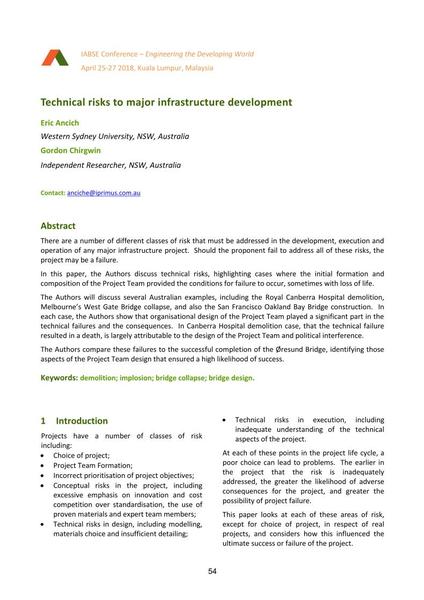Technical risks to major infrastructure development

|
|
|||||||||||
Bibliographic Details
| Author(s): |
Eric Ancich
(Western Sydney University, NSW, Australia)
Gordon Chirgwin (Independent Researcher, NSW, Australia) |
||||
|---|---|---|---|---|---|
| Medium: | conference paper | ||||
| Language(s): | English | ||||
| Conference: | IABSE Conference: Engineering the Developing World, Kuala Lumpur, Malaysia, 25-27 April 2018 | ||||
| Published in: | IABSE Conference Kuala Lumpur 2018 | ||||
|
|||||
| Page(s): | 54-67 | ||||
| Total no. of pages: | 14 | ||||
| DOI: | 10.2749/kualalumpur.2018.0054 | ||||
| Abstract: |
There are a number of different classes of risk that must be addressed in the development, execution and operation of any major infrastructure project. Should the proponent fail to address all of these risks, the project may be a failure. In this paper, the Authors discuss technical risks, highlighting cases where the initial formation and composition of the Project Team provided the conditions for failure to occur, sometimes with loss of life. The Authors will discuss several Australian examples, including the Royal Canberra Hospital demolition, Melbourne’s West Gate Bridge collapse, and also the San Francisco Oakland Bay Bridge construction. In each case, the Authors show that organisational design of the Project Team played a significant part in the technical failures and the consequences. In Canberra Hospital demolition case, that the technical failure resulted in a death, is largely attributable to the design of the Project Team and political interference. The Authors compare these failures to the successful completion of the Øresund Bridge, identifying those aspects of the Project Team design that ensured a high likelihood of success. |
||||
| Keywords: |
demolition bridge design bridge collapse implosion
|
||||
